Hello and welcome to another installment of A Song of Pins and Needles, where you, the lucky reader, get to watch me torture myself trying to understand the ugly costumes in a television show I loathe for around 3,000 words. I don’t know what that says about me (or you), but let’s not bury the lead: today we’re looking at the one, the only, Khaleesi.
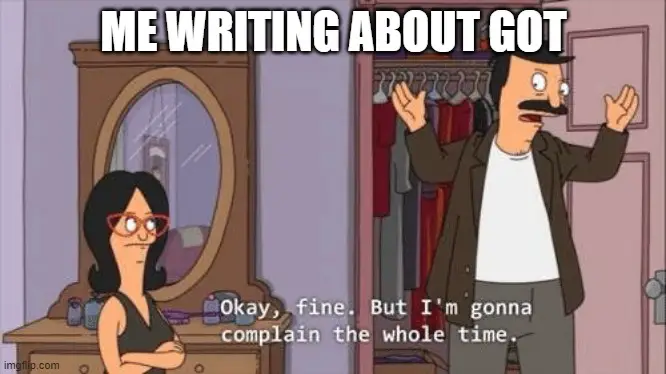
Recall that a watsonian analysis = looking at the story as it functions within the world, and a doylist analysis = considering the real-world reasons something happened in a story.
It should be noted at the outset that I am a HUGE Daenerys Targaryen supporter. I find her character and story arc intriguing in the source material, even her “Meereenese knot” plotline. Though George R.R. Martin doesn’t always explore racism as thoroughly as other issues, like misogyny, I do find there to be a critique of the White Savior trope in Dany’s failure as a leader in Essos and eventual realization that she is meant to conquer (though my guess is this critique is unfinished, as the book series is unfinished). I am also greatly compelled by Dany’s longing for home and how she grapples with the true meaning of “home” and “homeland”, as that’s something I’ve always found fascinating in human history and in literature.
Consequently, I am extremely protective of Daenerys Targaryen. And so, as a warning, this piece is likely to be on the sharper end of criticism, bordering on excessively salty. I considered toning it down, but then I remembered:

In fact my very first article with the Fandomentals covered most of Daenerys’s costumes up through season six. We pick up here with season seven and roll into season eight, covering the rise and fall of “Daenerys Targaryen” (hereinafter: “Deadpan”).
Some Things are Objectively Ugly
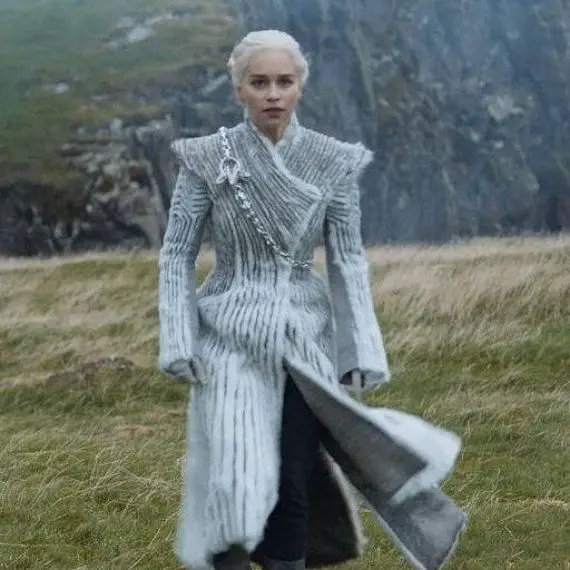
Generally, beauty is considered a subjective opinion. This coat is the exception. This coat is JUST. SO. UGLY. She looks like she’s wearing some weird medieval furry version of a pinstripe suit. And it’s a mess. The color isn’t exactly white – it’s off-white or cream, so it looks dirty. The back panel – which is supposedly gold (GOLD??) – looks like it got peed on by some creature. So the whole thing is gross. On top of it all, it looks messy because the lines never, not once on our screens, actually appear straight, even, or neat.
The geometry of the fur pattern is lost because of the fur’s pile (length). I don’t doubt that Michelle Clapton and her crew (hereinafter “Clapton & Co.”) constructed the coat properly for the lines to fall correctly – they’ve shown enough tailoring skills over the years that we can be confident that isn’t the issue. The problem is that the fur is too long, which means it moves on its own, and it moves in literally every direction. The result is that each vertical stripe on this meticulously tailored garment is visually lost because the fur obscures it; which makes the whole thing look disheveled.
I know for a fact that it’s possible to make this coat and avoid this problem because I’ve seen multiple cosplayers on the interwebs in the last three years reproduce this coat with greater finesse. The fact that the actual garment looks like a disaster, and was immediately reproducible by the layman to a greater degree of quality, is a problem for a multi-billion dollar television show.
With that rant out of the way, let’s get down to business: Watsonian analysis.
In terms of making sense in-universe, the coat is perfectly mediocre. It’s appropriate for the conditions simply by virtue of being a long-sleeved fur coat. Any deeper thought on it, though, immediately produces unanswerable questions. Why doesn’t she have a cloak or a hood? Every other character we’ve seen in the north wearing a coat at least has a cloak. Is the coat also fur-lined? Fur on the outside of a garment does basically nothing for warmth; the fur needs to be inside to make a difference. Why is it white? And no, I don’t mean why isn’t she wearing her house colors – a different issue entirely – I mean what animal did this white fur come from? No one else ever has white fur. The only other example of white fur (maybe fur?) was on Sansa’s white wedding dress in season five.
Though I suppose there is one more source…
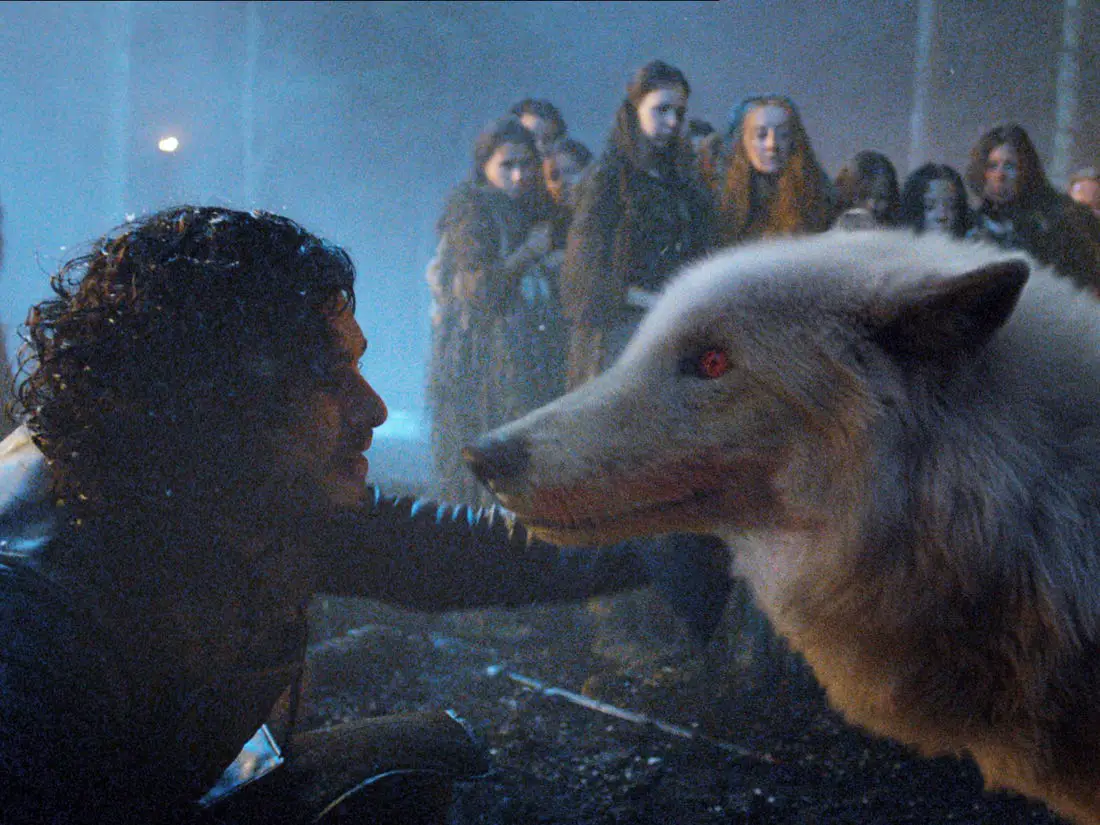
The pattern is also out-of-place. We never see anything else pinstriped or geometric like this in the series. The best I can pull from the source material is that court fools who wear motley can also wear stripes, but that isn’t at all illuminating. The pattern is a neat concept that didn’t end up executing well, and doesn’t fit in with the landscape of clothing we’ve seen. It’s sort of like some of Sansa’s season seven and eight costumes – it feels weirdly modern in a decidedly medieval setting.
The fact that she’s got nothing covering her head is just ridiculous. Like, not even earmuffs, my dudes? Everybody noticed the impracticality of riding a dragon through the winter skies further north and not wearing a hat! However, in case you were concerned, rest assured: Clapton & Co. specifically designed this outfit with practicality in mind:
“And [the coat] was very practical, because she’s riding a dragon.” – Michelle Clapton
So they legitimately thought this was sufficient. For the winter. In the north. ON A DRAGON. I don’t know if they’re lying to us, or if they’re that stupid.
My favorite bit of doylist commentary, though, comes from Michele Clapton’s further illuminating explanations:
“I felt like this was her dressing to rescue someone because she felt for them, rather than as a move to acquire more power. It was a romantic coat; it was something she wanted to wear that she’d be noticed in. She was like a descending angel. It was nothing to do with her personal gain.” – Michelle Clapton
IT’S A ROMANTIC COAT. CAN’T YOU SEE THE ROMANCE? DON’T YOU FEEL THE TENSION?? Literally no one felt this romance. It was and remains the “most informed of informed attributes,” as our very own Julia once put it. And the fact that anyone would think this garment is romantic is ludicrous. And do we even need to talk about the blatant sexism of saying the motivation for a woman to wear a coat in the winter is that she wants to be noticed??
The word salad contained in this quote is similar to what we usually see: the addition of background motivation and complexities that do not make Watsonian sense and, more importantly, are never portrayed on screen. I’m beginning to think D&D, and Clapton & Co. by extension, have a fundamental misunderstanding of symbolism and metaphor, and how to imbue something with deeper meaning. In fact, “meaning” in a literary way can be both Doylist and Watsonian.
An event, item, color, pattern, or whatever really, can have meaning to a character within a story. The character can acknowledge that meaning, think about that meaning, and grapple with it like a real human. But generally, that is not the source of great symbolism in works of literature (or other media). Nobody hails George R.R. Martin for making any of the Lannisters refer to themselves as lions, for example – that’s just a character acknowledging their house sigil. There are no levels of meaning there. By contrast, Martin’s use of foreshadowing in A Game of Thrones where the characters find a dead direwolf and stag does have levels of meaning (even if they are quite obvious); and while the characters may think it is an odd thing or even a bad omen, it has a meaning beyond the confines of their fictional brains and gives meaning directly to the reader in a Doylist way.
Costume design can do this, and I think based on things Michele Clapton says this is often what she is trying to do. For example, Sansa’s coronation dress – by virtue of it being pale grey and her hair being red – innately resembles a weirwood tree. This detail, whether intentional or not, adds a layer of meaning to the costume that reaches the viewer in a way that it need not reach the character: that Sansa has become the physical embodiment of old northern mysticism as she takes on the ancient title of the Kings in the North. By contrast, Sansa’s embroidery of weirwood leaves on the sleeves of that garment is a direct use of symbolism that is clearly recognized by the characters within the universe. There’s a difference.
Clapton & Co. frequently blurs these lines, and often to the detriment of the garment. Daenerys wouldn’t be thinking about how she wants to appear when she goes to rescue Jon Snow – but her appearance matters for the viewer. The audience doesn’t need a hackneyed backstory for why Daenerys is wearing white; we need an actual reason that white matters to us. And in the end, it doesn’t. Would another color? Maybe. Maybe not. But as it stands, nothing about the design of this coat provides any additional meaning to what is happening on screen.
Daenerys wears several more nearly identical white coats through season 8 that all recall the same questions as above. My guess is that the initial white coat was so well-received that Clapton & Co. just copied+pasted it to fill out the wardrobe. Considering Clapton & Co.’s understanding of color symbolism – having previously commented on Daenerys wearing grey and white while in Essos, and of course the incredible tidbit that blue is a Dothraki power color – it’s odd to me that Daenerys would be portrayed in so much white in the episodes leading up to her “turn” to Mad Queen. Perhaps part of the problem with that turn is that, two episodes before, she was bedecked in this “romantic” white coat as she swooned over Jon Snow. Let’s keep the importance of visuals in mind as we analyze Daenerys’s Evil turn in the penultimate episode.
But before that, I have a new fun concept for you! It’s called: the chain of intent.
“She can’t have a crown, she hasn’t conquered yet… But I loved this [idea] of this chain of intent.” – Michele Clapton
I wish Clapton had gone on to explain this more, because I’m sure we would’ve been gifted an even greater word salad. Much like the needle and the necklace, this chain of intent calls for so many questions. The first is, of course, what in seven hells is a chain of intent??? And so my immediate thought was the following:
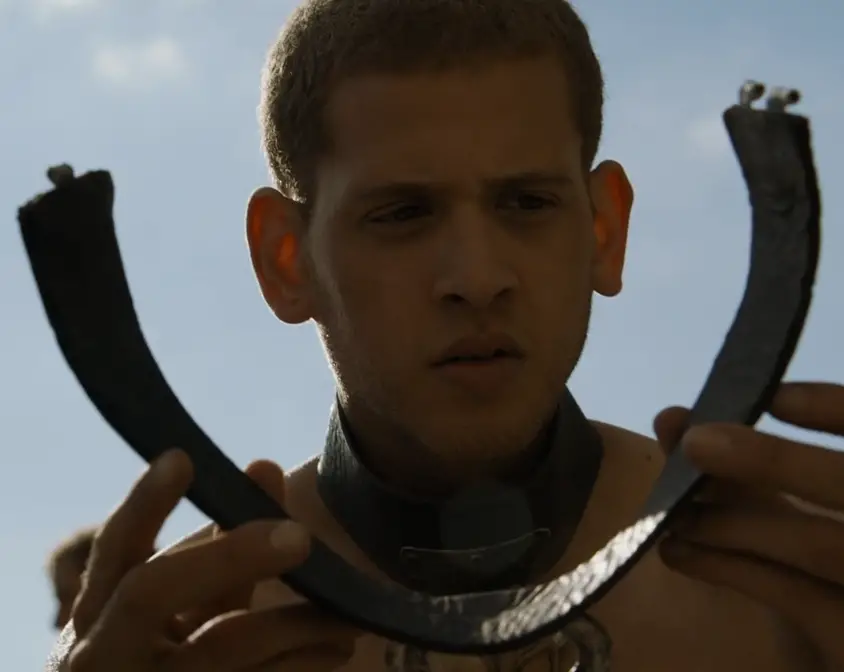
If a chain has any intent at all, it is to capture, hold, or tether. You know, like slave chains. Like the chains Daenerys used to lock up her dragons. Like the chains she is world-famous for breaking (in the show). Like the chains she refuses to put people in (see, e.g., the Tarlys). If the loose narrative of this story has taught us anything, it’s that chains are bad and Daenerys, specifically, cannot be chained or controlled – she is a dragon, and dragons cannot be locked up. Ornamenting Daenerys with a physical “chain of intent”, however beautiful it is, makes absolutely no sense at this stage in the story.
If anything, this design would’ve worked in Meereen, when Daenerys was trying to be someone she is not. She could have worn the chain for her time there and then had it burnt off or lost when she escapes Daznak’s pit on Drogon. That would have been symbolism.
Unless this was some extreme foreshadowing device – that Daenerys would really be enslaving Westeros, not saving it, and that was her intent with this chain – it just doesn’t fit. At least, this explanation doesn’t fit. The chain itself is fine and holds her little cloaks on, and looks medieval enough to fit into the world. We didn’t need the explanation; and the Doylist lens reveals, again, fundamental misunderstandings of metaphor.
Generic Black Dresses of Doom
Through season 7 and 8, Daenerys wears a series of generic black dresses that are all *almost* identical, but slightly different – you know, like real people do.
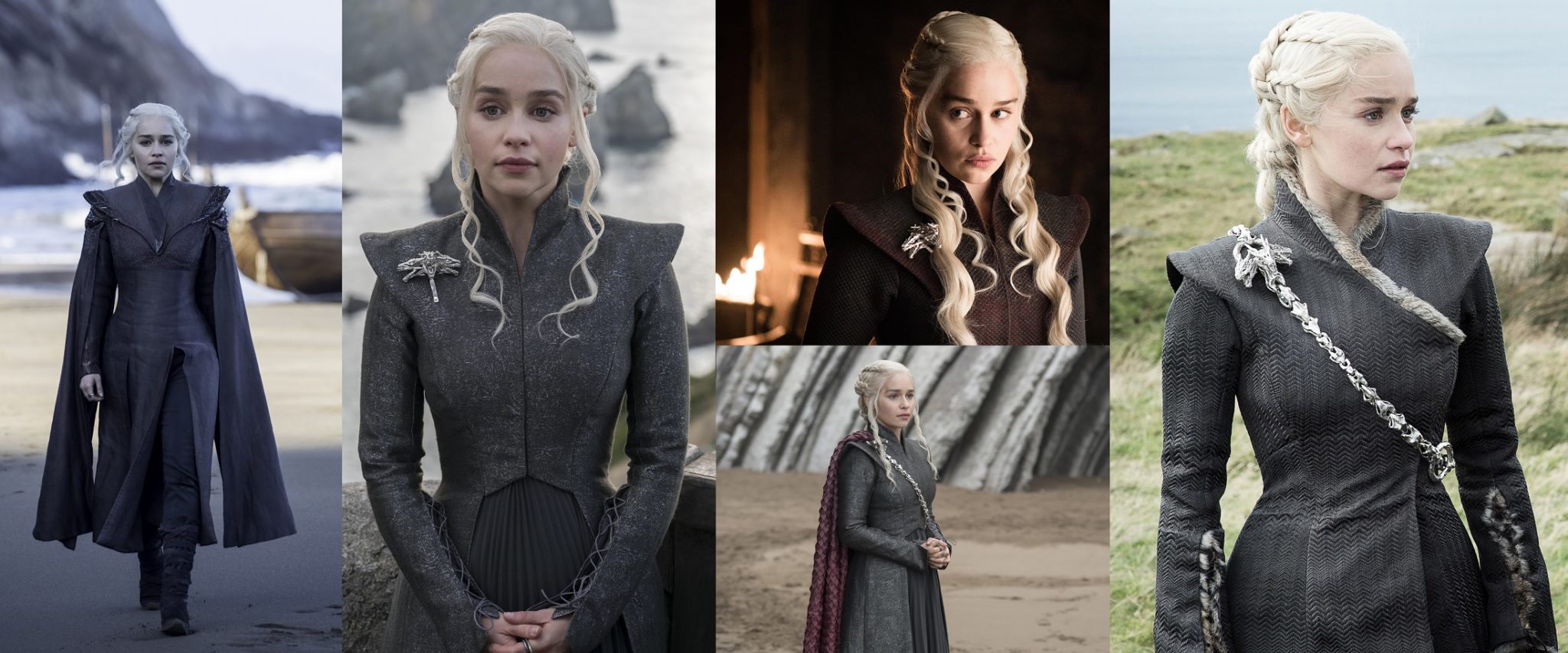
I mean at least it’s a step above cartoon character outfits that are the exact same every episode, I guess?
There’s nothing really wrong with these dresses; but there’s also nothing really right with them, either. They’re all like a solid C-minus. I find the length of the skirt odd. The ankle-cut makes an already short Emilia Clarke look even shorter. The white sash in this iteration looks like a shmata. Though her outfit with the red sash is one of my favorite looks for Daenerys in the whole series.
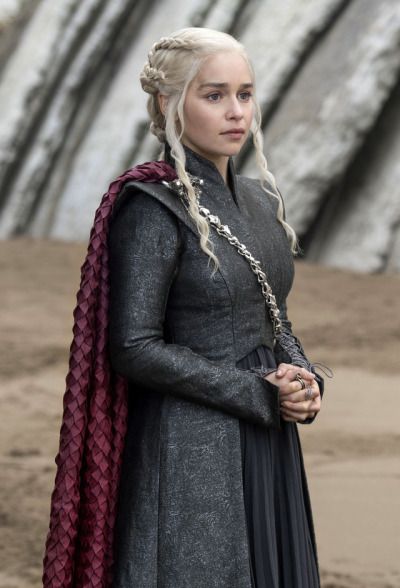
Y’all know I’m a sucker for those myrish knife-pleats.
Like all perfectly mediocre things in this god foresaken television show, Clapton & Co.’s commentary on it leaves me scratching my head. Clapton was asked about Daenerys’s white coat, and her other season 7 costumes, and explained that the wide shoulders were a homage to her brother, Viserys.
“The silhouette,” she explains, “purposely echoes that of the Targaryen style that her brother wore in Season 1.” – Michele Clapton
This is literally the picture they show in the article, to prove the silhouette is uniquely Targaryen.
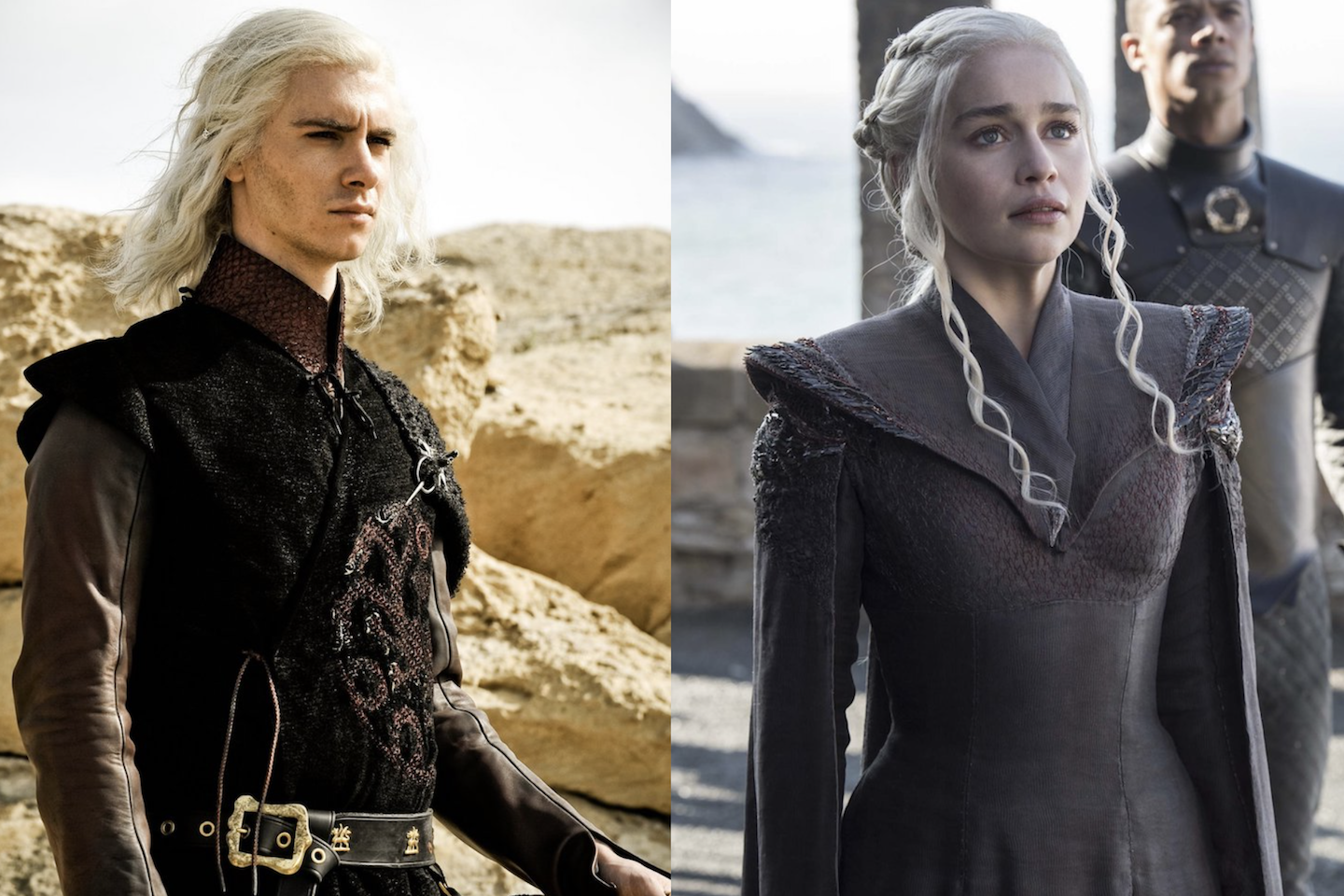
I guess that Margaery Tyrell, Tyrion Lanniser, Sansa Stark, Ellaria Sand, and literally any character with shoulders and a torso is also sporting that famous Targaryen Silhouette. Just more fuel for those secret Targaryen theories!
There’s only so many ways to make a garment. And shoulder pads are, well, shoulder pads. They make pretty much the same silhouette no matter what. Could this be a nod to Viserys? Maybe, but if it is, it’s just as much a nod to Darth Sansa. Why would Daenerys harken back to Viserys? If she wanted to embody Targaryen style, you’d think maybe she’d try to dip into her house colors for a change. You know, fire and blood. I wonder what color that would be…?
Ah, right – black, grey, white, and blue, of course. Can’t forget blue.
What even is divine right, amiright?
“She can’t have a crown, she hasn’t conquered yet,” – Michele Clapton
“I liked that she’s wearing everything she can to show her status but she can’t wear the crown because it’d be wearing it before it was due. You can see in the way [Dany is] dressing that she’s almost assuming the power but not quite. … The width of the shoulders give her strength, the chain gives her strength,” – Michele Clapton
This is a nitpick, I recognize that; but somebody needs to explain divine right to the entire D&D crew. Their misunderstanding of the concept is often revealed in their repeated “break the wheel” speeches, because how is Daenerys, the absolutist monarch who claims the throne by birthright, ever supposed to break the wheel of feudalism?? Daenerys may not wear a crown for several reasons, including that her family’s crown was pawned, or that she doesn’t want to present herself as more worthy than her followers, or maybe because the Essosi don’t have that custom. But at no point would Daenerys ever think she couldn’t wear a crown because she hadn’t conquered yet: the whole point of divine right is that Daenerys has always been the rightful queen to Westeros, and has always deserved to wear the crown. There is no requirement for her to earn it, when her claim is based on inheritance and divine right. In fact, it would probably be smart for Daenerys to hit the beaches of Dragonstone and get herself a crown to put forward that queenly image.
Again, a nitpick. But c’mon, Clapton & Co.! Basic stuff here!
What’s in a braid?
Long-time listeners of Unabashed Book Snobbery will know that I have problems with Deadpan’s hair. Broadly, I think her hair from season 6 and on looks ridiculous, because no human person has that much hair on her head. After perusing some articles I discovered a theory that the purpose behind Deadpan’s increasingly complex braids is that they reflect the Dothraki culture. The more battles a Dothraki warrior wins, the more braids he gets; and that’s why Deadpan keeps getting hella new braids.
Except that’s not true! In both the source material and the first episode of this show, it is established that a Dothraki warrior’s braid is only cut if he loses a fight – and so someone like Khal Drogo, who was undefeated, has a super long braid. Not multiple braids.
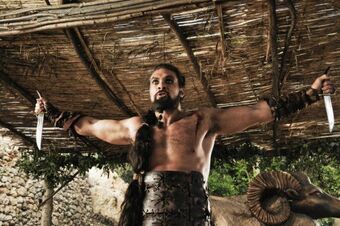
Work with me here, people!
Now, in fairness, this is an internet theory and not a confirmed Clapton & Co. reasoning. However, I gotta say, it sounds VERY authentic to the feel of this show and how it repeatedly misses the point. And it makes me wonder if this IS the doylist reason they continually increase Deadpan’s braid complexity. If so, this fundamental misunderstanding of Dothraki culture reveals again their lack of attention to detail, and/or their lack of concern with consistency in world-building. I think consistency is something that is particularly important to consider with Deadpan’s character, and her “turn” at the end, so we’ll come back to that.
I was studying Deadpan’s hair in season 7 and 8 (and I rewatched scenes of this show for this, so y’all better be grateful), hoping to find some relation to her mad queen turn. What I found instead was an interesting difference in her hair style between her “romantic” scenes, and her “mad queen” scenes. For example:
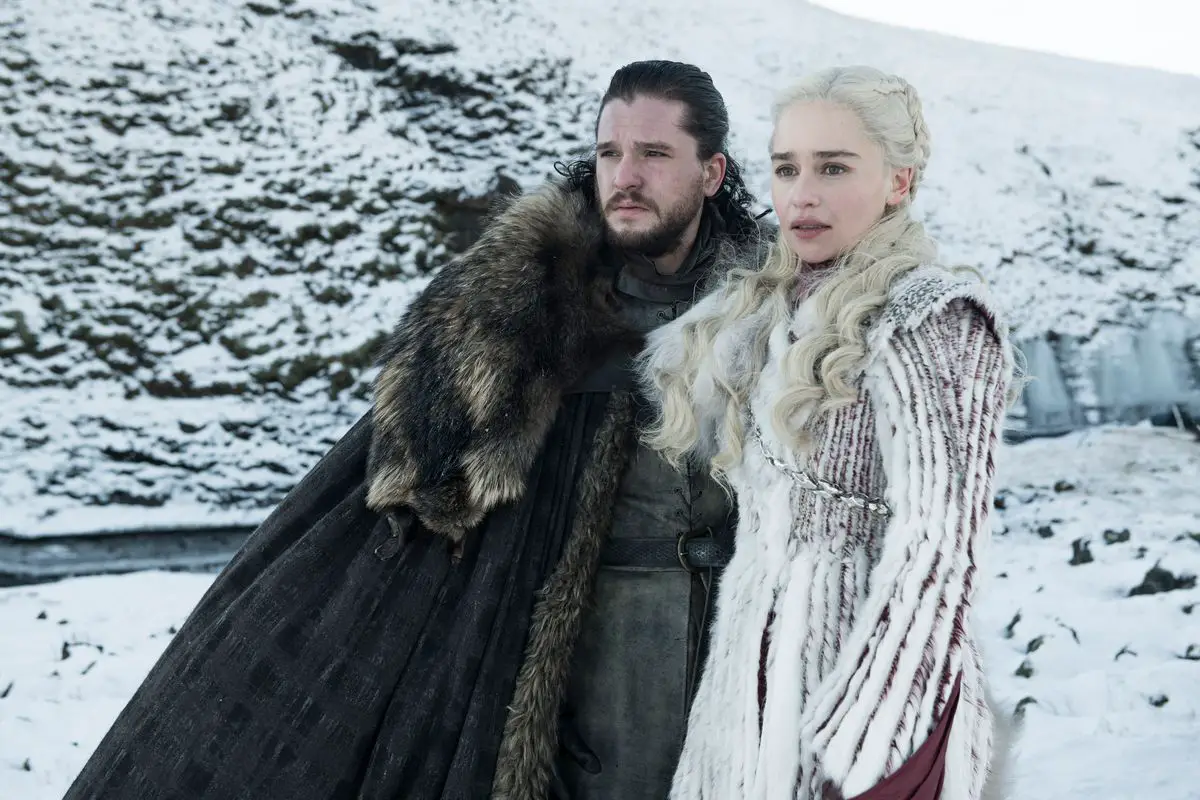
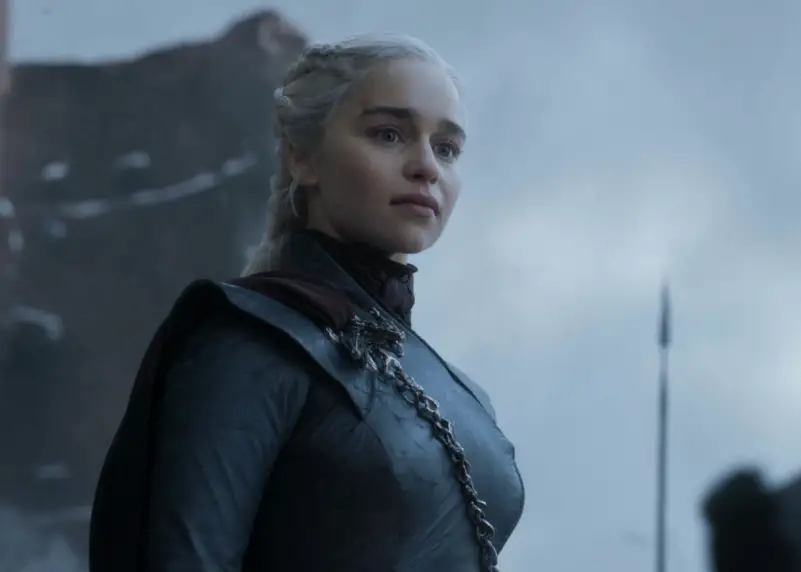
Her hair in the “romantic” scenes is curled, with long locks falling over her shoulders, in a more stereotypically “feminine” look; whereas her hair in her “mad queen” scenes is tight and pulled back, almost hidden from the camera. I thought it was just determined by dragon riding requirements (not wanting her hair flying all over the place to film those scenes), but realized she rode a dragon both in a romantic scene and a mad queen scene. And so, knowing the pattern of this show, I wondered if it was sexism. At first I thought I was being unfair to make that assumption – but then I thought about the queen Deadpan was fighting against in season 8:
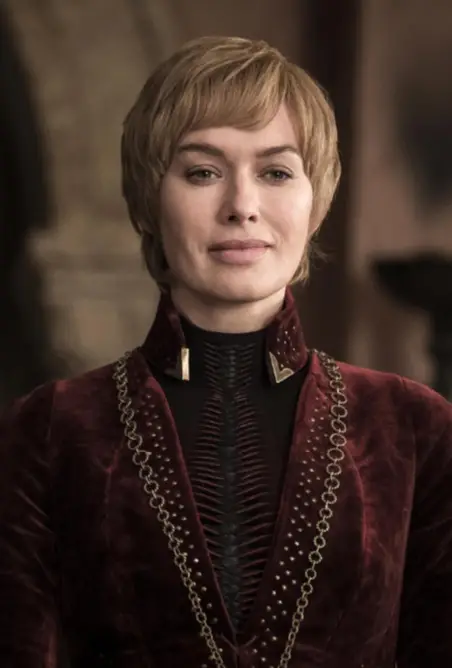
In the same way the costume designers link feminine clothing and colors to weakness, I believe they link feminine hair – long hair – to weakness as well. It’s really more the inverse: that they link masculinity to strength. But by virtue of attaching masculinity to an adjective like strength, you’re innately putting it on a spectrum where weakness is femininity. And that spectrum is visually represented on our screens by the hair style choices of the lead female characters in this show.
There isn’t a deeper meaning to it than that. It’s sexism, again. This simpleness of thought when it comes to design is best appreciated when we finally turn to Deadpan’s final look: the mad queen.
Shades of Evil
It took me a long time to figure out something intelligent to say about this final look on my darling favorite character, “Daenerys Targaryen”. And I realized through much soul searching that, for once, I do not have any Watsonian complaints about this outfit. My entire issue with it is Doylist in nature; and I think it is the Doylist reasoning – or lack thereof – that is the most revealing of perhaps the greatest problem underpinning the entire series Game of Thrones.
I didn’t have much to say on this costume for a long time because the problem with it is just so obvious: it’s basic. It’s a basic, generic, “evil” costume – it’s black leather (spooky!) with gloves (oooo! spooky!) and buttoned-up to the chin (emotionless and cold and spooky!!!). They might as well put a mask on her and call her Darth Khaleesi. We all immediately noticed the Nazi and/or fascist imagery evoked as she stood before the army of Unsullied. And don’t even get me *started* on the dragon wings schtick.
I rolled my eyes so hard they almost fell out of my head.
Clapton & Co. are not new to using black and white as a visual cue for the audience to distinguish who is good and who is evil. We saw the exact same dichotomy with Sansa Stark: her black tier three warlock costume signaled that she is strong and manipulative, and finally “a true player in the game of thrones,” as D&D always said; meanwhile, her white “angel costume” as one commentator at PostGameOfThrones described, when she gets married to Ramsey signals to us not only her virginity, but also her goodness, so that she can be good in relation to Ramsey and, of course, his evil girlfriend Myranda.
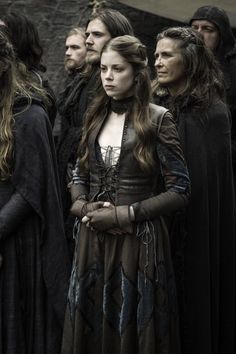
Check out that evil leather and evil v-neck!
And of course, we see a similar color palette shift with Cersei Lannister, when she changes from the Good Queen Carol and emerges from the chrysalis to become evil Cheryl. She wears black for the rest of the series! And you know what? It’s mostly leather!!! Spooooooky!!!
There are dozens of examples of this good/evil dichotomy being presented by the white/black monochrome, and it all comes back to the same problematic premise: it’s basic. This is children’s story level stuff. You know there’s a reason the Patronus is bright white and chases away the dark, cloaked dementors – because it’s a very easy metaphor to represent someone’s inner light or darkness with literal light and darkness.
George R.R. Martin has specifically commented on disliking the simple black/white dichotomy, and designing his world to combat those tropes. Indeed, the entire group of front-line heroes we have at the Wall is wearing black, while the evil, force-of-nature mythical beings are physically, literally white. This is clearly subverting the fantasy expectations of light and darkness being physically manifested in appearance, to a greater purpose of commentary on the genre. And what did D&D do?
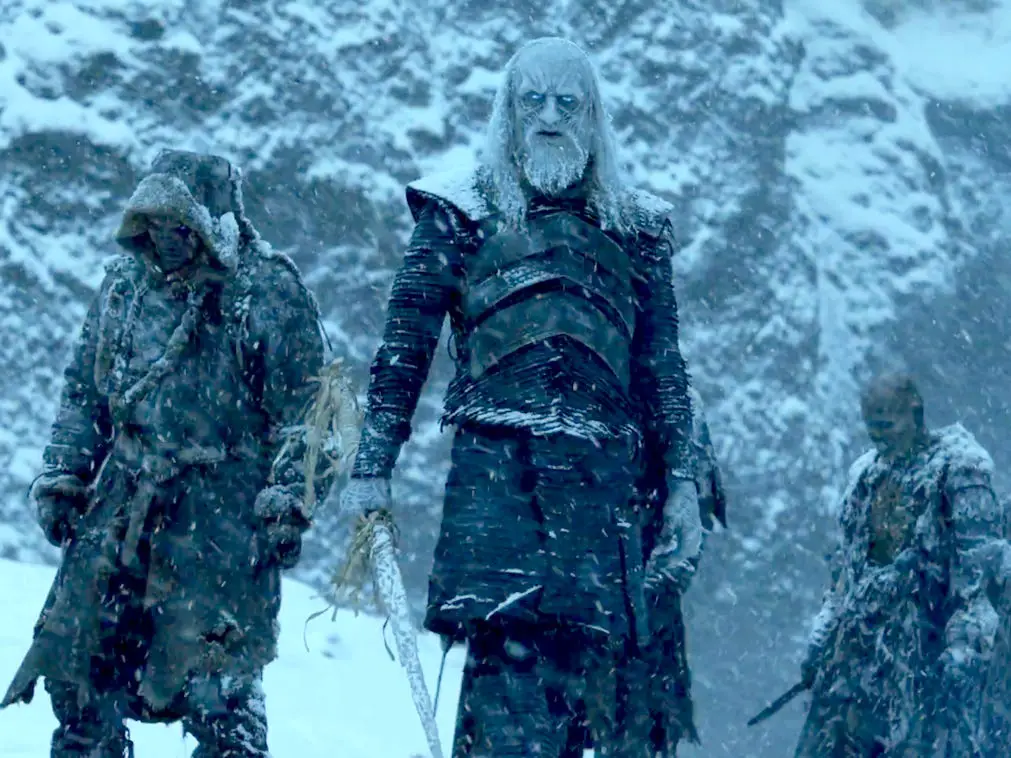
They dressed the white walkers in black. /Facepalm.
Game of Thrones is basic. The problem is that A Song of Ice and Fire is anything but basic. It actually plays on the reader’s genre expectations, too many specific points of meta-commentary. And of all the characters in that universe, Daenerys Targaryen is EXTREMELY complex. Nothing about Dany is simple, and nothing about what she’s doing – assimilating into the Dothraki culture, raising dragons for the first time in hundreds of years, navigating the Essosi cultures, freeing slaves, inciting revolutions and causing violence, and discovering her own identity as a conqueror – none of that is simple. So it is impossible to adapt that story into something that is simple. It impossible to make this story about good and evil, black and white; and so it is jarringly out of place to put this character in an evil queen, Darth-Vadar, black leather getup with two episodes to go.
The “turn” to Mad Queen felt wrong to the majority of viewers, but it’s true that it wasn’t entirely unseeded. So why didn’t that turn work? Part of it, I think, is how inconsistent the rampage of evil violence felt in the context of Daenerys’s character. I mentioned earlier that consistency is particularly important when studying Deadpan. It is inconsistent to have a character literally end slavery in a geographical portion of the world, and then indiscriminately kill civilians, including children. It is inconsistent to have a character be earnestly in love with someone, and then worry that his claim is better than hers, rather than realizing they could get married. It’s inconsistent, for that matter, to have a character in her “romantic” coat flirting with a guy in episode two, help save the world in episode three, and then demolish a city that has already surrendered in episode five. It. Is. Inconsistent.
There is a difference between writing a character that is going “mad” and writing someone inconsistently. A great example of a character who loses her grip on reality is Azula, from Avatar: The Last Airbender. And I feel like there are examples of this from the source material…
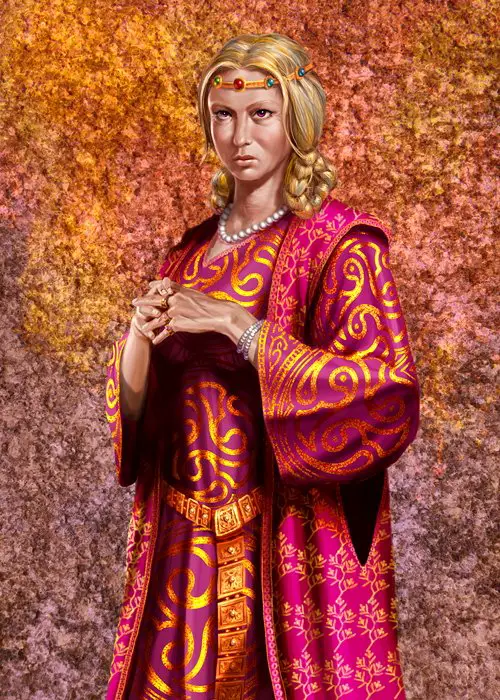
*Rhaenyra looks directly at the camera*
What D&D did with Deadpan came across as inconsistent, not as a downward spiral into madness. And that’s a fault primarily of the writing, but is not helped by the ham-fisted costume choices. Putting Daenerys in black leather only highlighted visually for the audience how weird the whole “turn” was, as Deadpan was color-coded as “Evil”. This robbed her “turn” of any potential moral grayness, and therefore robbed it not only of believability, but also of fascination.
What’s interesting in stories about evil is that we are all capable of it to some degree – it’s something that is shared as part of the human condition. Indeed, good and evil is often in conflict within a person, and it’s “the heart in conflict with itself” that is the greatest thing to write about. It is the shades of grey – not the black and white – that are interesting. Tyrion Lannister is a compelling character because he is a (dark) shade of grey: he is targeted because of how he looks, which we as readers know is wrong and so we feel sympathy for him, but he’s also a pretty bad dude. Jaime Lannister is a shade of grey, especially when it comes to his formative moment when he betrayed his king and simultaneously saved millions. And Daenerys Targaryen is absolutely a shade of grey, even if she consistently tries to be on the good end of the spectrum. It’s just the nature of the human condition; and it is the reason A Song of Ice and Fire is so compelling.
Game of Thrones lacks those shades of grey, both metaphorically and literally through it’s costume design. So it’s not just that the mad queen costume is basic; it’s that the costume physically represents one of the most fundamental problems with the adaptation – that it simplifies everything. I would argue that, at this point, it isn’t even an adaptation, given its disregard for the purpose of the source material.
The fun of shades of grey is that it engages the audience and makes us think, makes us analyze and choose sides, and exercise empathy. Imagine if Deadpan had another reason for burning King’s Landing, instead of hearing bells.
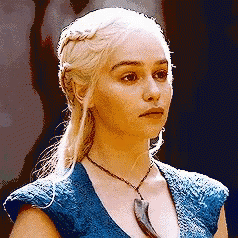
Imagine that Deadpan heard the bells and stopped the attack, and then Cheryl used that moment to launch an attack on Drogon and injured him (non-fatally). Cheryl using the surrender bells as a trick, and hurting her last dragon, could cause Daenerys to get angry and go sicko mode. And then maybe Deadpan burns down the whole city in retaliation. Still not a good enough reason to kill all those people – but way more understandable to feel that sort of rage after a trick and an injured Drogon, as opposed to “bells”.
Now imagine Deadpan’s final costume wasn’t black at all, but it was blood red. The colors of her house: fire and blood. Myself, as someone who is predisposed as an admitted Targaryen loyalist, I think that would be so badass awesome and I would be totally here for it. And it’s the kind of color that gives you, visually, what the story is trying to give you: danger, a dash of evil, and a heavy spoonful of power.
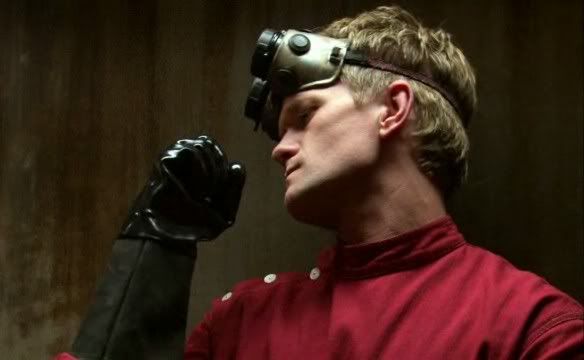
Ah, a girl can dream.
This basic story, with these basic costumes, runs into a bad implications problem real fast. As our wonderful Gretchen described:
“The implications of this are so awful, because he’s talking about… she’s this woman who burned all of these evil men who are trying to hurt her and do terrible things to her – and they keep on saying ‘men’, they don’t say ‘people’, it’s specifically ‘men’ – she is a woman who is killing ‘bad men’. And then you have her conversation with Jon where she talks about how like, why should I make space for men who represent these old oppressive structures in my new world? And he seems to be implying that she needs to forgive the men who’ve betrayed her, and hurt her, and tried to rape her, and are oppressing people. And that if she doesn’t make space for people who cling to these old ways and oppressive structures, that she deserves to die and is crazy! Like the implication is that Dany deserves to die because she doesn’t want to make space for men who represent oppressive structures. And that’s bullshit.”
UBS 8×06 “The Iron Throne” Gretchen
As the kids these days say: bet.
Conclusion
In sum, as I say goodbye to the character assassination that is Deadpan Cardborn, I see the embodiment of the core problem with this entire television show: the writers were not smart enough to write it. Period.
Stay tuned for one final installment of A Song of Pins and Needles, where we will examine the Good Queen Cheryl Lannister.
Have strong thoughts about this piece you need to share? Or maybe there’s something else on your mind you’re wanting to talk about with fellow Fandomentals? Head on over to our Community server to join in the conversation!

